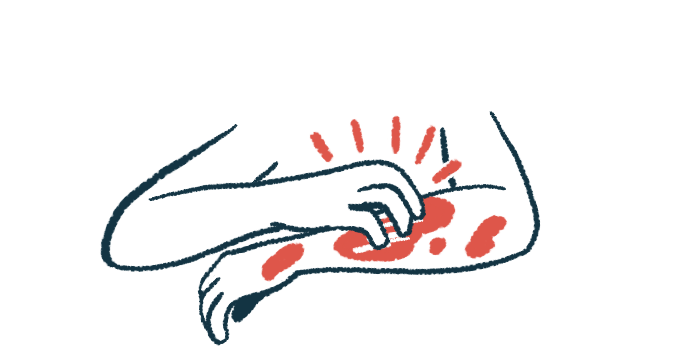Dupilumab works as itching treatment in Alagille case: Report
Therapy, sold as Dupixent, eased hard-to-treat itch in woman, 18
Written by |

The use of dupilumab, an approved anti-inflammatory antibody-based treatment, worked to ease itching, known medically as pruritus, in a young woman with Alagille syndrome after several other anti-itch medications had failed, a study reported.
Dupilumab is prescribed in the U.S., under the brand name Dupixent, for treating certain inflammatory conditions, including skin diseases marked by itchy skin.
The researchers here say it could potentially be a treatment for itching in Alagille syndrome.
“Given the intractable and chronic nature of the pruritus caused by [Alagille], further study into the use of dupilumab should be considered,” the researchers wrote.
The woman’s treatment was described in “Management of refractory pruritus in Alagille syndrome with dupilumab treatment: A case report,” published in JAAD Case Reports.
Several medications used off-label to treat itching in Alagille
Alagille syndrome is an inherited condition, usually caused by mutations in the JAG1 gene, that’s marked by developmental problems in several organs.
One issue is fewer than normal bile ducts to drain bile out of the liver. Bile is a digestive fluid produced by the liver that is transported to the intestine, where it helps break down fatty molecules during digestion.
In Alagille patients, such impaired bile flow, a condition called cholestasis, leads to bile accumulation in the liver and leakage into the bloodstream, causing symptoms like severe itching.
People with Alagille may develop severe liver damage and are at higher risk of developing hepatocellular carcinoma, the most common type of liver cancer.
Two oral medications, Livmarli (maralixibat) and Bylvay (odevixibat), are approved to ease itching related to Alagille. Other therapies are also commonly used off-label to manage this burdensome symptom, including the antibiotic rifampin and ursodeoxycholic acid (UDCA), sold as Urso and other brand names.
However, in cases of treatment-resistant itch, “the use of biologics may be needed,” the researchers wrote. Biologics are medications derived from living organisms.
Dupilumab is a biologic antibody-based therapy that suppresses the activity of two pro-inflammatory proteins, thereby reducing inflammation, but not affecting immune responses. It is administered through subcutaneous, or under-the-skin, injections.
Treatment with other medications failed to relieve woman’s itching
Now, researchers in the U.S. described the successful treatment of Alagille-related itching in an 18-year-old woman from Puerto Rico after several other medications had failed to work.
The woman had sought treatment with dermatologists due to lifelong severe itching that did not respond to the initial use of rifampin and UDCA. Livmarli treatment also had been attempted, but she discontinued it due to facial rash.
On physical examination, the patient had facial features typical of Alagille’s, including a prominent forehead and straight nose with a flattened tip. She also had bumps of thick skin, typical of chronic itching and repeated scratching, on her arms and legs.
Due to her chronic and treatment-resistant itching, the woman was started on dupilumab, at a 600 mg loading dose, and then 300 mg every other week, together with triamcinolone, 0.1% ointment twice a day. Triamcinolone is an anti-inflammatory medication used for several skin conditions.
After six weeks, she reported a significant reduction in itching. On a severity scale from 0 to 10, her itching dropped from 9.5 before treatment to 6 afterward. She was continuing treatment with dupilumab, once every two weeks.
Dupilumab also used for patient’s mother, who had similar symptoms
The patient’s mother, a 45-year-old woman, also reported symptoms similar to her daughter’s and suggestive of Alagille, including lifelong itching, distinctive facial features, and skin bumps in the extremities.
The researchers noted that the mother also had hepatocellular carcinoma, for which she had started treatment. Her father and paternal uncle also had liver cancer.
Considering the familial history of liver cancer and her daughter’s diagnosis, the mother was also suspected of having Alagille syndrome, which researchers suggested could be the cause of her itching and liver cancer.
Six weeks of treatment with triamcinolone ointment twice a day had no effect on the mother’s itching. She then started the same dupilumab regimen as her daughter. After three weeks, her itching had not eased and she developed new skin bumps that the researchers deemed likely related to the anti-cancer therapies.
Still, the patient was recommended to continue treatment with dupilumab for both itching and new skin lesions.
To our knowledge, these are the first reports which … describe the occurrence of ALGS [Alagille syndrome] in a family of Puerto Rican descent and … utilize dupilumab for [treatment-resistant itching] secondary to ALGS with mixed results.
According to the researchers, this report details several firsts.
“To our knowledge, these are the first reports which … describe the occurrence of ALGS [Alagille syndrome] in a family of Puerto Rican descent and … utilize dupilumab for [treatment-resistant itching] secondary to ALGS with mixed results,” the researchers concluded.
While the woman’s mother “did not note a reduction in pruritus, she had additional complicating factors,” they added, including active liver cancer, treatment with anti-cancer agents, and a new skin problem likely caused by anti-cancer medication.
Further studies are needed to assess dupilumab’s therapeutic potential in Alagille, the researchers concluded.









